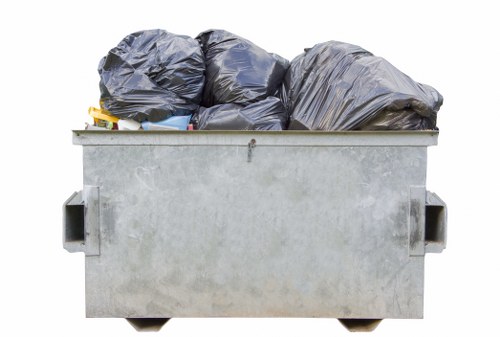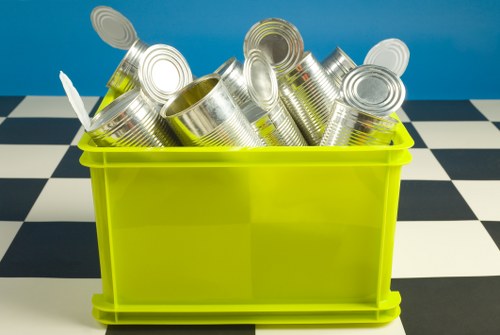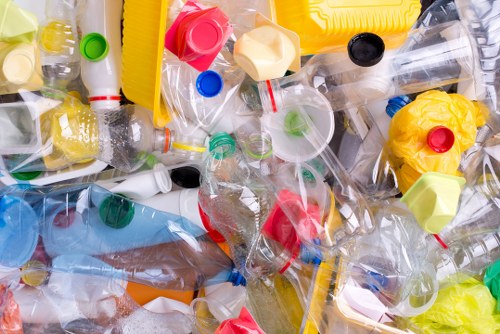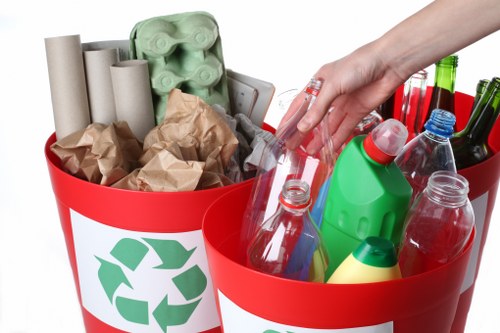Waste Disposal in Stamford Hill: A Comprehensive Guide

Proper waste disposal is essential for maintaining a clean and healthy environment in Stamford Hill. With increasing population and urbanization, the challenges associated with waste management have become more complex. This guide provides an in-depth look at the waste disposal options available in Stamford Hill, offering practical solutions and insights for residents.
Understanding the various types of waste and the appropriate disposal methods is the first step towards effective waste management. Whether it's household waste, recyclable materials, or hazardous substances, each category requires specific handling to ensure safety and sustainability.
Stamford Hill offers a range of waste disposal services designed to cater to the diverse needs of its community. From regular curbside collections to specialized recycling programs, residents have access to multiple channels for managing their waste responsibly.

Types of Waste in Stamford Hill
Waste can be broadly categorized into several types, each requiring different disposal methods:
- Household Waste: Commonly includes kitchen scraps, paper, plastics, and general rubbish.
- Recyclable Materials: Items like glass, metals, paper, and certain plastics that can be reprocessed.
- Hazardous Waste: Includes batteries, electronics, chemicals, and medical waste that require special handling.
- Bulky Waste: Large items such as furniture, appliances, and garden waste.
- Electronic Waste: Disposed electronic devices like computers, phones, and TVs.
Proper categorization of waste is crucial for efficient disposal and recycling efforts. Mismanagement can lead to environmental pollution and health hazards.
Stamford Hill has implemented several programs to address these different types of waste, ensuring that each category is handled appropriately and sustainably.

Waste Disposal Services in Stamford Hill
Regular Waste Collection
The Stamford Hill area benefits from regular waste collection services provided by the local council. These services typically include:
- Scheduled curbside pickups for household waste
- Recycling collection on designated days
- Collection of bulky and hazardous waste through special arrangements
Residents are encouraged to follow the collection schedule and guidelines to ensure their waste is picked up efficiently and recycled materials are processed correctly.
Recycling Programs
Recycling is a vital component of waste management in Stamford Hill. The council provides facilities and resources to support recycling efforts, including:
- Recycling bins for separate collection of paper, glass, metals, and plastics
- Electronic waste collection points for safe disposal of gadgets
- Community recycling centers offering drop-off services for larger items
Participating in recycling programs helps reduce the overall waste footprint and promotes environmental sustainability.

Hazardous Waste Disposal
Handling hazardous waste requires careful attention to prevent environmental contamination and health risks. Stamford Hill residents can dispose of hazardous materials through:
- Designated hazardous waste collection days
- Special drop-off locations equipped to handle dangerous substances
- Guidelines for safe storage and transportation of hazardous materials
It's essential to follow the council’s instructions when disposing of hazardous waste to ensure proper treatment and disposal.
Bulky Waste Collection
Large items that cannot be disposed of through regular waste collection require special arrangements. Stamford Hill offers bulky waste collection services where residents can schedule pickups for items like:
- Furniture
- Appliances
- Garden waste
Alternatively, residents can take bulky waste to designated drop-off points, ensuring these items are disposed of responsibly.

Effective Waste Management Tips for Stamford Hill Residents
Reduce, Reuse, Recycle
Adopting the principles of reduce, reuse, and recycle can significantly minimize the amount of waste generated:
- Reduce: Minimize the purchase of disposable items and opt for products with minimal packaging.
- Reuse: Find new uses for old items instead of discarding them.
- Recycle: Separate recyclable materials and ensure they are placed in the correct bins.
Implementing these practices helps conserve resources and reduce the strain on waste disposal systems.
Proper Sorting of Waste
Sorting waste correctly is key to effective recycling and disposal. Stamford Hill provides clear guidelines on how to categorize waste, making it easier for residents to comply:
- Separate recyclables from non-recyclables
- Dispose of hazardous waste at designated centers
- Flatten cardboard boxes to save space
Proper sorting ensures that recyclable materials are processed correctly and reduces the volume of waste sent to landfills.
Community Involvement: Engaging the community in waste management initiatives can lead to more effective disposal practices. Stamford Hill encourages residents to participate in local clean-up events and educational programs.
Education and Awareness: Informing residents about the importance of proper waste disposal and the available services can drive better participation and compliance.
By working together, the Stamford Hill community can create a cleaner and more sustainable environment for everyone.
Local Recycling Centers in Stamford Hill
Recycling centers play a crucial role in managing waste sustainably. Stamford Hill is home to several recycling facilities that accept a variety of materials:
- Stamford Hill Recycling Depot: Accepts glass, paper, metals, and certain plastics for recycling.
- Electronic Waste Facility: Specialized in handling and recycling electronic devices safely.
- Bulky Waste Collection Point: Dedicated to collecting large items that cannot be processed through regular waste streams.
These centers provide residents with the necessary resources to dispose of their waste responsibly, ensuring materials are recycled efficiently.
Accessibility and Hours of Operation
Recycling centers in Stamford Hill are conveniently located and operate during accessible hours to accommodate residents’ schedules. It is recommended to check the specific hours and accepted materials before visiting to ensure a smooth experience.
10 Nearby Areas to Stamford Hill and Their Waste Disposal Features
Stamford Hill is surrounded by several neighboring areas, each offering unique waste disposal solutions:
- Finsbury Park: Offers extensive recycling programs and community clean-up events.
- Highgate: Known for its efficient bulky waste collection services.
- Archway: Provides specialized hazardous waste disposal facilities.
- Tower Hill: Features multiple recycling centers with diverse material acceptance.
- Seven Sisters: Hosts regular waste collection days with clear guidelines for residents.
- Upper Edmonton: Supports electronic waste recycling through dedicated drop-off points.
- New Southgate: Implements neighborhood-wide waste reduction initiatives.
- East Barnet: Offers comprehensive waste management services, including composting options.
- Tottenham: Known for its proactive approach to hazardous waste handling.
- Whetstone: Provides convenient access to bulky waste collection and recycling centers.
Each of these areas complements Stamford Hill’s waste management efforts, creating a network of support for sustainable disposal practices.
Residents moving between these areas can take advantage of the diverse waste disposal services, ensuring their waste is managed responsibly wherever they are.
The Importance of Sustainable Waste Disposal
Sustainable waste disposal is vital for preserving the environment and ensuring public health. By adopting eco-friendly practices, Stamford Hill residents can contribute to a cleaner and greener community:
- Environmental Protection: Reducing waste helps minimize pollution and conserve natural resources.
- Public Health: Proper waste management prevents the spread of diseases and reduces exposure to harmful substances.
- Economic Benefits: Efficient waste disposal can lower costs associated with waste management and promote recycling industries.
Emphasizing sustainability in waste disposal practices ensures long-term benefits for both the community and the environment.
Innovative Waste Management Solutions
Stamford Hill is exploring innovative solutions to enhance waste disposal efficiency. These include:
- Composting Programs: Encouraging organic waste composting to reduce landfill burden and produce useful compost for gardening.
- Waste-to-Energy Initiatives: Converting non-recyclable waste into energy to provide a renewable energy source.
- Smart Waste Bins: Utilizing technology to monitor waste levels and optimize collection routes.
These innovations aim to make waste management more effective and environmentally friendly.
Challenges in Waste Disposal
Despite the robust waste management systems, Stamford Hill faces several challenges in waste disposal:
- Increasing Waste Volume: Population growth leads to more waste generation, putting pressure on disposal services.
- Recycling Contamination: Improper sorting of recyclables can contaminate the recycling stream, reducing its effectiveness.
- Funding and Resources: Adequate funding is essential to maintain and improve waste disposal infrastructure.
- Public Awareness: Educating residents about proper waste management practices remains an ongoing effort.
- Space Constraints: Limited space for waste storage and recycling facilities can hinder effective waste management.
Addressing these challenges requires collaborative efforts between the community, local authorities, and waste management providers.
Solutions to Overcome Challenges
To tackle the challenges in waste disposal, Stamford Hill can implement the following solutions:
- Enhancing Public Education: Increase awareness campaigns to educate residents on proper waste sorting and recycling practices.
- Investing in Infrastructure: Allocate funds to upgrade waste disposal facilities and introduce advanced technologies.
- Promoting Waste Reduction: Encourage practices that minimize waste generation, such as using reusable products.
- Strengthening Regulations: Implement stricter regulations to prevent illegal dumping and ensure compliance with waste management guidelines.
These measures can help mitigate the challenges and improve the overall efficiency of waste disposal in Stamford Hill.
Future of Waste Disposal in Stamford Hill
The future of waste disposal in Stamford Hill is geared towards sustainability and innovation. Key initiatives include:
- Zero Waste Goals: Striving to eliminate landfill waste through comprehensive recycling and reuse programs.
- Advanced Recycling Technologies: Investing in technologies that improve the sorting and processing of recyclable materials.
- Community Engagement: Fostering a community-driven approach to waste management, encouraging participation and responsibility.
- Circular Economy: Promoting a circular economy where products are designed for longevity, reuse, and recycling.
By adopting these forward-thinking approaches, Stamford Hill aims to become a model for effective and sustainable waste management.
Collaboration between residents, businesses, and the local government will be crucial in achieving these ambitious goals.
Conclusion
Effective waste disposal in Stamford Hill is a collective responsibility that requires commitment from both the community and local authorities. By understanding the types of waste, utilizing available disposal services, and adopting sustainable practices, residents can contribute to a cleaner and healthier environment.
Stamford Hill's comprehensive waste management strategies, combined with innovative solutions and community involvement, pave the way for a sustainable future. Embracing these practices ensures that the area remains a vibrant and eco-friendly place to live.
Frequently Asked Questions
1. How can I schedule a bulky waste collection in Stamford Hill?
You can schedule a bulky waste collection by contacting the local council’s waste management department through their website or by phone. Ensure you provide details about the items you wish to dispose of and arrange a suitable pickup time.
2. What items are considered hazardous waste in Stamford Hill?
Hazardous waste includes batteries, electronics, chemicals, paints, and medical waste. These items require special handling and should be disposed of at designated hazardous waste facilities or during scheduled collection days.
3. Are there any recycling incentives for residents in Stamford Hill?
Yes, Stamford Hill offers various incentives such as reduced waste collection fees for households that consistently separate and recycle their waste properly. Additionally, some recycling centers may offer rewards for certain types of recyclable materials.
4. Where can I dispose of electronic waste in Stamford Hill?
Electronic waste can be disposed of at the Electronic Waste Facility located in the area. You can also participate in scheduled e-waste collection events or drop off items at designated recycling centers.
5. What should I do if my recycling bin is contaminated?
If your recycling bin is contaminated with non-recyclable items, contact the local waste management service to report the issue. They may provide guidance on proper sorting or arrange for additional pickups if necessary.